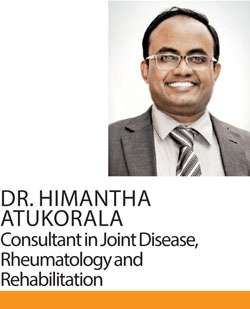10 Aug 2018 - {{hitsCtrl.values.hits}}

 There seems to be a constant debate on what food does to our bones and joints. Various myths exist regarding health benefits of vitamins on bone growth and joint repair. I intend to elaborate further on how the latest research has cleared some of these myths. A healthy diet is needed to prevent joint disease and I will also give some suggestions on modifying meals in the following article. We spoke to Dr. Himantha Atukorale, MBBS(Colombo) MD, Consultant in Joint Disease, Rheumatology and Rehabilitation to educate our readers on food and arthritis.
There seems to be a constant debate on what food does to our bones and joints. Various myths exist regarding health benefits of vitamins on bone growth and joint repair. I intend to elaborate further on how the latest research has cleared some of these myths. A healthy diet is needed to prevent joint disease and I will also give some suggestions on modifying meals in the following article. We spoke to Dr. Himantha Atukorale, MBBS(Colombo) MD, Consultant in Joint Disease, Rheumatology and Rehabilitation to educate our readers on food and arthritis.
What does food do to our joints?
“First of all I should emphasise the importance of losing weight to protect the weight bearing joints. Obesity is now becoming a major problem among many patients I encounter. And weight gain goes hand in hand with hip, knee, ankle and foot pain. In a condition called osteoarthritis one of the first steps we should take is to loose a considerable amount of weight. As you might already be aware of, we take into account an indices called Body Mass Index (BMI) in weight management programmes” Dr. Atukorala explained. This is a simple calculation where weight in kilograms is divided by height in metres times two (the square value of height). Sri Lankans are meant to have an ideal BMI of less than 23 kg/m2 . It is therefore useful for arthritis patients to have low BMI’s.
A diet rich in antioxidants and omega 3 fatty acids is proven through research to help joint disease. The best example is a Mediterranean diet. This has green leaves, salads, olives and oily fish.
I am a fan of dairy products. Milk has not only calcium, but Vitamin D. Vitamin D helps in absorbing calcium and is a regulator in bone construction

Another finding is about a healthy diet in arthritis to protect against heart disease, strokes and vascular diseases. Arthritis is considered as an independent risk factor in having strokes, heart and blood vessel diseases. Therefore a healthy diet is essential if you have arthritis.
“A diet rich in antioxidants and omega 3 fatty acids is proven through research to help joint disease. The best example is a Mediterranean diet. This has green leaves, salads, olives and oily fish.
I am a fan of dairy products. Milk has not only calcium, but Vitamin D. Vitamin D helps in absorbing calcium and is a regulator in bone construction. When patients complain that they do not have access to fresh milk I advise them to use curd. Curd is a concentrated source of milk and doesn’t contain added sugar” he added.
Is weight reduction possible?
“This is a burning issue faced by many patients. Some prefer to avoid any form of discussion on weight reduction. I have a simple solution. Always try to calculate the amount of energy you ‘Burn’ per day. And limit your food intake to balance the energy expenditure” Dr. Atukorala said.
Talking about carbohydrates, bakery food items are the main culprit for the present obesity issue. Unrefined carbohydrates are the proper thing. So in simple terms, avoid buns, pastries, cakes and eat legumes like cowpea, chickpea or green gram. The carbs in these are gradually absorbed so you won’t get that surge of sugar in the bloodstream. These have soluble fiber which lowers cholesterol levels. Legumes are rich in minerals as well.
Oils and fats
Did you know that by cutting down the fat intake by 30 grams a day you tend to avoid 270 kilo calories? When fat/oil is eaten, unless you exercise, this gets deposited in your body.
Saturated fat is a major ingredient of cakes, biscuits and pastries. It’s also the key component in vegetable oil (palm oil). Saturated fat is known to increase joint inflammation/ swelling. Therefore it is considered harmful to joints. “Unfortunately in South Asian countries palm oil which is marketed as vegetable oil is rapidly becoming popular. One research reported that humans consumed an average 17 pounds (7.7 kg) of palm oil per person in 2015. I feel that palm oil intake is alarmingly high among Sri Lankans. Not just joint disease, palm oil can increase the risk of heart disease. Margarine made in Sri Lanka has palm oil as the key ingredient” the doctor added.
Another important food ingredient we all should avoid is transfats. Food items like fast food (burgers, hot dogs), margarine, icing on the cakes and baked food have lots of trans fats. These are proven to increase the joint inflammation. USA recently banned unsafe food items that include trans fats. Therefore certain types of margarine aren’t sold there. Transfats also increase the risk of heart disease.
Does Omega-3 reduce joint inflammation?
I will explain this in simple terms. In 1991 two researchers Cremmor and Robinson published evidence that omega 3 fatty acids are protective against joint inflammation. This was more evident in joint diseases such as rheumatoid arthritis, ankylosing spondylitis and psoriatic arthritis.
Some food items that contain omega 3 are oily fish ( Jack Mackerel , Sardine and Salmon), Rapeseed and Flaxseed Oils and Walnuts.
Another ingredient called omega 6 also might cause problems in people with joint disease. Sunflower oil and corn oil have omega 6. These can increase inflammation of joints. Coconut oil has no known side effects to joint disease and therefore is considered safe in moderation.
Fruits and vegetables
Fresh fruits and vegetables are rich in anti oxidants. These clear away free radicles which can harm our joint structure. So fruits and vegetables are good protecting agents for joint diseased patients. Remember to eat plenty of green leaves, vegetables and brightly colored fruit containing lots of anti-oxidants.
Saturated fat is a major ingredient of cakes, biscuits and pastries. It’s also the key component in vegetable oil (palm oil). Saturated fat is known to increase joint inflammation/swelling. Therefore it is considered harmful to joints.
Short note on Gout
Whenever I talk about food and joints, I am asked about Gout. So what is Gout and what does it do to our joints? Uric acid is a waste product that gathers within our bodies. This is usually pushed out through the kidneys. If someone produces excess uric acid, this tends to form crystals especially inside the kidneys or joints. When crystals gather inside the joints, they irritate the joint interior causing severe pain and swelling. We call this Gout. The same thing could happen inside the kidneys or the tubes called ureters which lead out of the kidneys. Then certain “Uric acid stones/calculi” are formed similar to kidney stones.
What precipitates Gout? In individuals who form excess uric acid episodes of fever, diarrhea and dehydration can cause an attack of Gout. When these patients eat lots of red meat, seafood containing uric acid ingredients or drink alcohol such as beer, they could experience an episode of Gout. If the Gouty joint swelling is seen over the 1st big toe of the foot we call it podagra.
There are medications to be given during the initial attack. And some tablets such as Allopurinol is given later on to avoid future episodes of Gout. Patients who have severe kidney disease are also at risk of Gout as their kidneys do not push out uric acid as healthy people do.
22 Dec 2024 3 hours ago
22 Dec 2024 3 hours ago
22 Dec 2024 6 hours ago
22 Dec 2024 6 hours ago
22 Dec 2024 6 hours ago